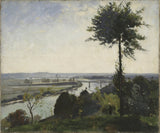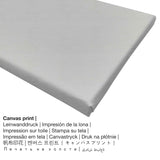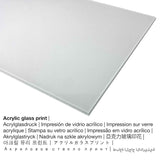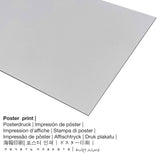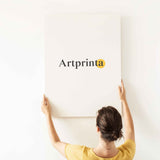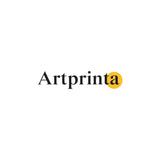Carl Fredrik Hill, 1877 - Osisi na Osimiri III (The Seine na Bois-le-Roi) - ọmarịcha nka.
Ụtụ gụnyere. Mbupu gbakọrọ na ndenye ọpụpụ.
Nhọrọ akụrụngwa ngwaahịa gị
Nchịkọta nhọrọ ngwaahịa na-enye gị ohere ịhọrọ ihe na nha ọkacha mmasị gị. Ị nwere ike ịhọrọ n'ime nhọrọ nhazi ngwaahịa ndị a:
- Kwaaji: A canvas direct print is a printed canvas mounted on a wood frame. Also, a canvas print creates a lively, appealing look. Canvas Prints have the great advantage of being low in weight, which means that it is quite simple to hang the Canvas print without the support of additional wall-mounts. Because of thata canvas print is suited for any type of wall in your home.
- Bipụta akwụkwọ mmado n'ihe kwaaji: Our poster is a UV printed canvas with a slightly roughened surface texture, that reminds the original artwork. Please note, that depending on the absolute size of the poster print we add a white margin between 2-6cm around the artwork to facilitate the framing with a custom frame.
- Bipụta na iko acrylic na-egbuke egbuke (nke nwere ezigbo mkpuchi iko): An print on acrylic glass, often described as a print on plexiglass, makes your favorite original artwork into gorgeous wall decoration. The great advantage of a plexiglass fine art print is that sharp contrasts plus painting details become more identifiable with the help of the fine tonal gradation of the picture. The plexiglass with real glass coating protects your selected fine art print against light and heat for up to six decades.
- Metal (aluminium debond mbipụta): Aluminium Dibond prints are prints on metal with an outstanding depth effect - for a modern impression and a non-reflective surface. The bright parts of the artwork shine with a silky gloss, however without the glow. The direct UV print on Aluminum Dibond is the most popular entry-level product and is a truly contemporary way to showcase art, as it draws attention on the artwork.
Ozi dị mkpa: We try our best in order to depict the products as precisely as it is possible and to illustrate them visually on the different product detail pages. Nonetheless, the tone of the print materials and the imprint might diverge somehwat from the presentation on the device's monitor. Depending on the screen settings and the quality of the surface, not all colors can be printed 100% realistically. Bearing in mind that all our are printed and processed manually, there may also be slight discrepancies in the exact position and the size of the motif.
What does the Nationalmuseum Stockholm write about this artwork from the painter Carl Fredrik Hill? (© Copyright - by Nationalmuseum Stockholm - National Museum nke Stockholm)
English: Like Ernst Josephson, Carl Fredrik Hill travelled to France with a burning ambition to make his mark as an artist. His encounter with the French countryside in the 1870s resulted in an intense and patient endeavour to capture the specific character of the landscape. He often reworked the same subject in several different versions. A number of variants exist of The Tree and the River, from 1877, this being the third. Here the artist has sought to combine strong daylight with the slightly hazy atmosphere of the landscape. Liksom Ernst Josephson reste Carl Fredrik Hill till Frankrike med en brinnande ambition att slå igenom som konstnär. Hans möte med den franska landsbygden på 1870-talet resulterade i ett intensivt och tålmodigt arbete med att fånga landskapets specifika karaktär. Ofta bearbetade han samma motiv i flera olika versioner. Trädet och flodkröken från 1877 existerar i flera varianter, varav detta är den tredje. Här har konstnären arbetat med att förena ett starkt dagsljus med landskapets svagt disiga atmosfär.
N'elu 140 ihe nka dị afọ bụ ndị mere nwoke Swedish artist Carl Fredrik Hill. The original had the dimensions: Ogologo: 50 cm (19,6 ″); Obosara: 60 cm (23,6 ″) Ekebere: Elu: 63 cm (24,8 ″); Obosara: 73 cm (28,7 ″); Omimi: 7 cm (2,7 ″). Ọ bụ akụkụ nke National Museum nke Stockholm art collection. With courtesy of: Nationalmuseum Stockholm & Wikimedia Commons (license - public domain).Creditline of the artwork: . Moreover, alignment of the digital reproduction is in odida obodo format na nwere akụkụ ruru nke 1.2: 1, nke na-egosi na ogologo bụ 20% ogologo karịa obosara.
Tebụl a haziri ahazi nke ihe osise
| Aha nka: | "The Tree and the River III (The Seine at Bois-le-Roi)" |
| Nchịkọta nke ọrụ nka: | sere |
| Nhazi nka: | nkà nke oge a |
| Century: | 19th narị afọ |
| Afọ nka: | 1877 |
| Afọ nka: | 140 afọ |
| Akụkụ nke ọrụ nka mbụ: | Ogologo: 50 cm (19,6 ″); Obosara: 60 cm (23,6 ″) Ekebere: Elu: 63 cm (24,8 ″); Obosara: 73 cm (28,7 ″); Omimi: 7 cm (2,7 ″) |
| Ụlọ ihe ngosi nka: | National Museum nke Stockholm |
| Ebe ngosi nka: | Stockholm, Obodo Stockholm, Sweden |
| Weebụsaịtị nke ihe ngosi nka: | National Museum nke Stockholm |
| Ụdị nka nka: | ngalaba ọha |
| Site n'aka: | Nationalmuseum Stockholm na Wikimedia Commons |
Nkọwa ngwaahịa ahaziri ahazi
| Ụdị edemede: | ezi nka mmeputakwa |
| Mmeputakwa: | mmeputakwa n'ụdị dijitalụ |
| Usoro mmepụta: | Mbipụta UV ozugbo |
| Mmalite ngwaahịa: | German mmepụta |
| Stockdị ngwaahịa: | mmepụta ihe na-achọ |
| Ngwaahịa were: | ihe ndozi mgbidi, ihe ndozi ụlọ |
| Nhazi nke ihe nka: | usoro odida obodo |
| Ụdị anya: | 1.2:1- ogologo: obosara |
| Mmetụta akụkụ: | ogologo bụ 20% ogologo karịa obosara |
| Nhọrọ akwa: | mbipụta akwụkwọ mmado (akwụkwọ kwaaji), mbipụta kanvas, mbipụta enyo acrylic (nwere ezigbo mkpuchi iko), mbipụta ọla (aluminium dibbond) |
| Nhọrọ nke akwa akwa n'elu etiti ihe ndọtị (mbipụta akwa akwa): | 60x50cm - 24x20", 120x100cm - 47x39", 180x150cm - 71x59" |
| Mbipụta iko acrylic (nke nwere ezigbo mkpuchi iko): | 60x50cm - 24x20", 120x100cm - 47x39", 180x150cm - 71x59" |
| Nhọrọ nke mbipụta akwụkwọ mmado (akwụkwọ kwaaji): | 60x50cm - 24x20", 120x100cm - 47x39" |
| Ụdị mbipụta aluminom dibond: | 60x50cm - 24x20", 120x100cm - 47x39" |
| Nhazi nke nka nka: | adịghị |
Tebụl nkọwa omenkà
| Aha onye nka: | Carl Fredrik Hill |
| Aha ndi ozo: | Carl Fredrik Hill, Carl Frederik Hill, Hill Carl Fredrik, Hill Carl Frederik |
| okike nke onye nka: | nwoke |
| Obodo onye nka: | Swedish |
| Ọrụ onye na-ese ihe: | onye na-ese ihe |
| Obodo obibi: | Sweden |
| Nhazi nke onye nka: | omenkà nke oge a |
| Nwụrụ anwụ: | 62 afọ |
| Afọ ọmụmụ: | 1849 |
| Amụrụ na (ebe): | Lund, Skane, Sweden |
| Afọ nwụrụ: | 1911 |
| Obodo ọnwụ: | Lund, Skane, Sweden |
© Copyright - Artprinta (www.artprinta.com)

